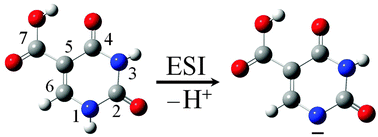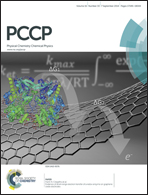Anionic derivatives of uracil: fragmentation and reactivity†
Abstract
Uracil is an essential biomolecule for terrestrial life, yet its prebiotic formation mechanisms have proven elusive for decades. Meteorites have been shown to contain uracil and the interstellar abundance of aromatic species and nitrogen-containing molecules is well established, providing support for uracil's presence in the interstellar medium (ISM). The ion chemistry of uracil may provide clues to its prebiotic synthesis and role in the origin of life. The fragmentation of biomolecules provides valuable insights into their formation. Previous research focused primarily on the fragmentation and reactivity of cations derived from uracil. In this study, we explore deprotonated uracil-5-carboxylic acid and its anionic fragments to elucidate novel reagents of uracil formation and to characterize the reactivity of uracil's anionic derivatives. The structures of these fragments are identified through theoretical calculations, further fragmentation, experimental acidity bracketing, and reactivity with several detected and potential interstellar species (SO2, OCS, CS2, NO, N2O, CO, NH3, O2, and C2H4). Fragmentation is achieved through collision induced dissociation (CID) in a commercial ion trap mass spectrometer, and all reaction rate constants are measured using a modification of this instrument. Experimental data are supported by theoretical calculations at the B3LYP/6-311++G(d,p) level of theory. Lastly, the astrochemical implications of the observed fragmentation and reaction processes are discussed.


 Please wait while we load your content...
Please wait while we load your content...